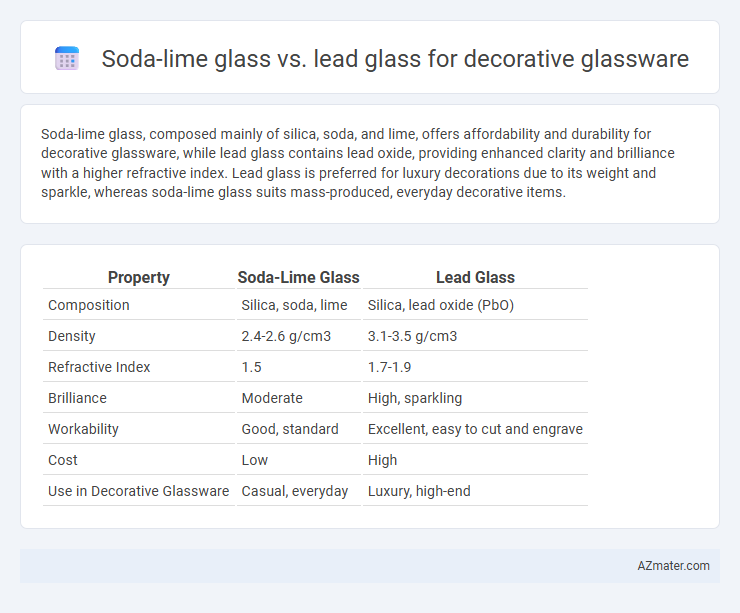Soda-lime glass, composed mainly of silica, soda, and lime, offers affordability and durability for decorative glassware, while lead glass contains lead oxide, providing enhanced clarity and brilliance with a higher refractive index. Lead glass is preferred for luxury decorations due to its weight and sparkle, whereas soda-lime glass suits mass-produced, everyday decorative items.
Table of Comparison
| Property | Soda-Lime Glass | Lead Glass |
|---|---|---|
| Composition | Silica, soda, lime | Silica, lead oxide (PbO) |
| Density | 2.4-2.6 g/cm3 | 3.1-3.5 g/cm3 |
| Refractive Index | 1.5 | 1.7-1.9 |
| Brilliance | Moderate | High, sparkling |
| Workability | Good, standard | Excellent, easy to cut and engrave |
| Cost | Low | High |
| Use in Decorative Glassware | Casual, everyday | Luxury, high-end |
Introduction to Decorative Glassware Types
Soda-lime glass and lead glass are two primary materials used in decorative glassware, each offering distinct characteristics. Soda-lime glass, composed mainly of silica, soda, and lime, provides durability and affordability, making it ideal for everyday decorative items. Lead glass, enriched with lead oxide, enhances brilliance and weight, resulting in a more luxurious appearance suited for premium decorative glassware.
What is Soda-lime Glass?
Soda-lime glass is the most common type of glass used in decorative glassware, composed primarily of silica (SiO2), soda (Na2O), and lime (CaO). It offers durability, affordability, and excellent workability, making it ideal for mass production of decorative items. Unlike lead glass, soda-lime glass has lower refractive index and brilliance but is more environmentally friendly and safer to handle.
What is Lead Glass?
Lead glass, also known as lead crystal, is a type of decorative glassware distinguished by its high lead oxide content, typically ranging from 24% to 30%, which enhances its refractive index and brilliance compared to soda-lime glass. This increased lead content imparts greater weight, clarity, and resonance, making lead glass highly prized for fine decorative pieces such as chandeliers, vases, and glassware. Unlike soda-lime glass, which is composed mainly of silica, soda, and lime, lead glass offers superior brilliance and is easier to cut and engrave, thus preferred in luxury and ornamental applications.
Chemical Composition Comparison
Soda-lime glass primarily contains silica (SiO2), sodium oxide (Na2O), and calcium oxide (CaO), providing durability and affordability for decorative glassware. Lead glass incorporates lead oxide (PbO) in concentrations typically between 20-30%, enhancing refractive index and brilliance but increasing weight and toxicity concerns. The chemical composition differences significantly affect optical properties and suitability for decorative applications.
Visual Clarity and Aesthetics
Soda-lime glass offers a clear, colorless appearance but may have slight impurities that affect visual clarity, making it suitable for everyday decorative glassware with moderate brilliance. Lead glass, also known as crystal, contains lead oxide which increases its refractive index, resulting in exceptional brilliance, clarity, and a sparkling aesthetic highly prized in luxury decorative glassware. The higher density and enhanced light dispersion of lead glass create more vivid reflections and a superior visual impact compared to soda-lime glass.
Weight and Durability Differences
Soda-lime glass is lighter and more durable compared to lead glass, making it better suited for everyday decorative glassware that requires strength and resistance to breakage. Lead glass is heavier due to its higher density and contains lead oxide, which enhances refractive qualities but reduces overall durability, making it more fragile and prone to chipping. The increased weight and delicate nature of lead glass give it a luxurious appearance but limit its practicality for frequent use.
Workability for Artisans
Soda-lime glass offers excellent workability for artisans due to its lower melting point and ease of shaping, making it ideal for intricate decorative glassware. Lead glass, with its higher refractive index and greater weight, provides brilliant clarity and luster but requires careful temperature control during working to prevent defects. Artisans prefer soda-lime glass for versatile designs, while lead glass is favored for luxurious pieces demanding precision and brilliance.
Safety and Health Considerations
Soda-lime glass is preferred for decorative glassware due to its non-toxic composition and lower risk of lead exposure, making it safer for household use. Lead glass, while offering superior brilliance and clarity, contains lead oxide, which poses health risks through prolonged contact or accidental ingestion, especially in items used for food and drink. Regulatory guidelines often restrict lead glassware in food-related applications to prevent lead leaching and associated toxicity.
Common Uses in Decorative Glassware
Soda-lime glass is widely used in decorative glassware due to its affordability, durability, and ease of shaping, making it ideal for everyday items like vases, bowls, and glass ornaments. Lead glass, also known as crystal, is prized for its high refractive index and clarity, commonly used in luxury decorative pieces such as chandeliers, fine stemware, and intricate figurines. Both types serve specific aesthetic purposes, with soda-lime glass favored for mass-produced items and lead glass reserved for high-end, collectible glassware.
Choosing the Best Glass for Your Needs
Soda-lime glass offers affordability and excellent durability, making it ideal for everyday decorative glassware with a clear, colorless appearance. Lead glass, containing 24-30% lead oxide, provides superior brilliance and weight, enhancing the visual appeal of luxury decorative pieces. Selecting the best glass depends on prioritizing factors such as cost-efficiency, brilliance, and the intended use of the glassware.

Infographic: Soda-lime glass vs Lead glass for Decorative glassware
 azmater.com
azmater.com